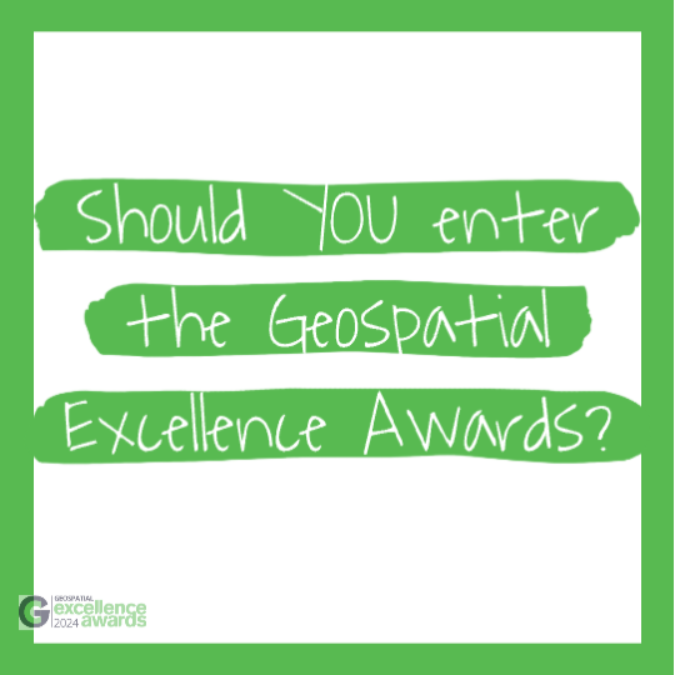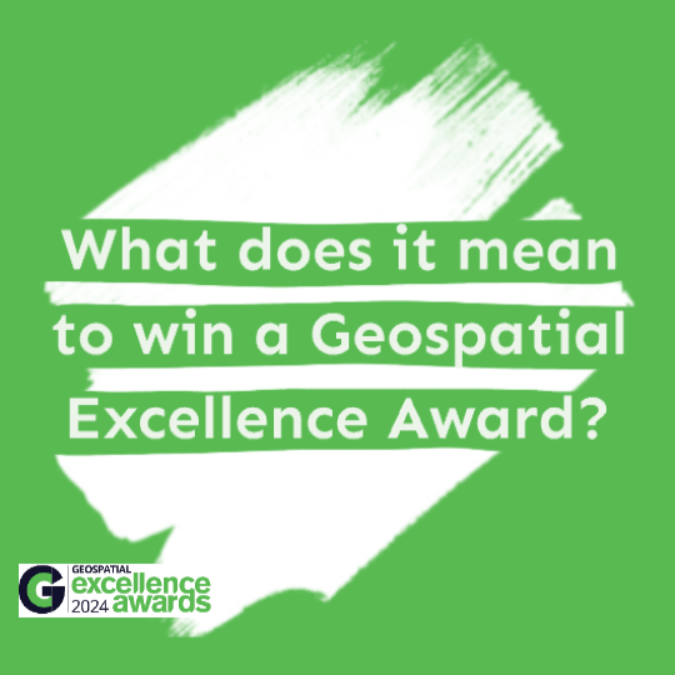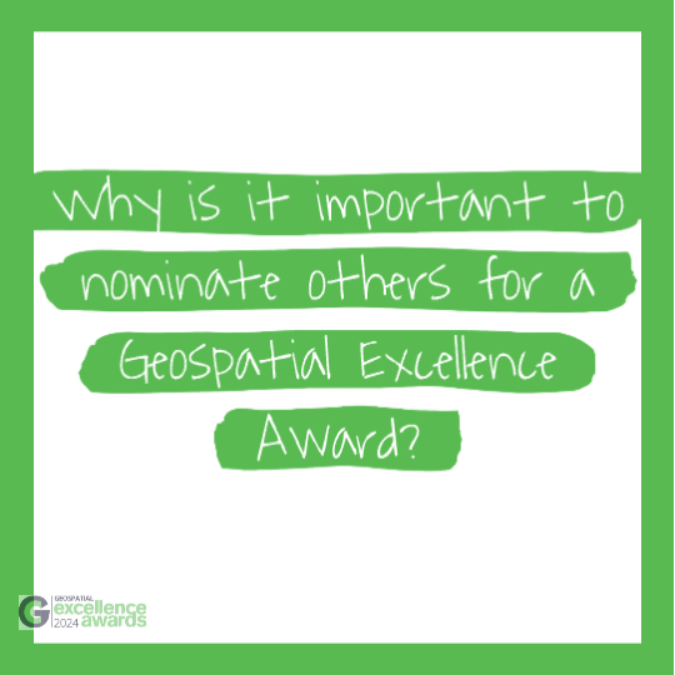Nominations now closed
Regional Awards Presentations:
- VIC | Melbourne – Friday, 9 August
- SA | Adelaide – Friday, 16 August
- NSW | Sydney – Friday, 30 August
- QLD | Brisbane – Thursday, 5 September
- TAS | Launceston – Friday, 20 September
- WA | Perth – Friday, 8 November
- NZ | Wellington – Wednesday, 20 November
- ACT | Canberra – Thursday, 21 November
Dates for the 2025 Awards Season will be announced later this year. Please keep an eye on GCA’s communications channels for details.
For all general enquiries please contact: awards@geospatialcouncil.org.au

Testimonials from Past Winners
Roshni Sharma
FrontierSI
Geoffrey Lawes
Revelere Systems
Jayne Robertson
Onneer
Ben Dawes
SiteDE
Award categories
FOR INDIVIDUALS
Professional of the Year Award
Nominee must be a current member of The Geospatial Council or S+SNZ.
A practitioner who is working in any of the disciplines of geospatial science whose professional achievements are acknowledged by peer citation as exemplifying the highest standards of excellence and ethical conduct.
The following criteria should be addressed:
- Outstanding performance in their occupation: focus on the achievements/performance of the nominee that are beyond the usual. For example, consider what makes the nominee outstanding in relation to their day-to-day business and/or how they may have changed the way their profession does business or solves problems.
- Service to the geospatial profession: Consideration should be given to committees that the nominee may have served on and representation roles, as well as roles in events such as coordinating and/or speaking at conferences.
- Held in highest respect by peers: e.g. list any awards or commendations that the nominee may have received in recognition from their peers or anecdotal evidence of standing amongst colleagues.
- Made a difference to the geospatial profession by their leadership: include professional initiatives that the nominee played a key role in that had have far-reaching impacts and other leadership roles.
- Recent contribution and achievements: highlight the activities undertaken, achievements and/or challenges overcome in the last 18 months.
Future Leader of the Year Award
Nominee must be a current member of the Geospatial Council or S+SNZ and approx. 15 years or less since entering profession.
This award recognises an early career professional who has performed at an exceptional level in their career to date and made substantial contributions in the field of geospatial science in the last 18 months.
The following criteria should be addressed:
- Outstanding performance in their occupation: focus on the achievements/performance of the nominee that are beyond the normal. For example, consider what makes the nominee outstanding in relation to their day-to-day business and/or how they may have changed the way their profession does business or solves problems.
- Leadership: Document examples where the nominee may have led a significant project, leadership roles in the workplace and leadership roles amongst geospatial professionals.
- Participation in professional committees and groups: Consideration should be given to committees that the nominee may have served on and representation roles.
- Ongoing continuing professional education: include nominee’s commitment to continuing professional development e.g. ongoing study, participation/attendance at events.
Diversity & Inclusion Award
This award recognises a geospatial professional who has improved, contributed to the improvement of, opportunities for those from diverse backgrounds and/or actively campaigned for a more inclusionary workplace or industry, in a way that has had a positive and long-term impact.
Diversity is about employing people who are different across a range of indicators such as age, gender, sexual orientation, industry background, cultural identity, ability as well as diversity of thinking approaches among many others. Inclusion is about valuing that difference and creating processes and cultures that enable a sense of belonging and psychological safety.
The following criteria should be addressed:
- Contribution to the profession: provide information on the nominee’s specific contribution to championing and building a more inclusive and diverse profession, either as an expert (e.g. research, teaching etc) or as an a role model or ally (e.g. championing difference and behaviours that lead to a more inclusive culture, including challenging inequality, barriers and bias etc).
- Impact: provide information about professional initiatives that the nominee has played a key role in that had have far-reaching impacts. Can the nominee demonstrate positive outcomes arising from their interventions for individuals, an organisation or the profession more widely.
Educational Development Award
This award is conferred on teachers, trainers, facilitators or academics who have substantially contributed through teaching, training, research, publications and/or professional activities to transfer skills and knowledge to others. It acknowledges leadership not only in empowering individuals and groups, but also in supporting others to acquire knowledge and/or promote excellence in the fields of geospatial science.
The following criteria should be addressed:
- Contribution to the education and learning of learning of individuals or community groups: focus on the specific achievements/performance of the nominee that are beyond the normal. For example, consider what makes the nominee outstanding in relation to delivering education.
- Contribution to the advancement and improvement of education: consideration should be given to any surveying, spatial or related committees that the nominee may have served on, representation roles and contribution to educational publications or programs or courses e.g. the linking of geospatial professionals with teachers. Document examples where the nominee is involved in CPD activities such as certification and event organisation/speaking.
- Significant leadership in an education role: include any activity involving significant leadership such as supervision of postgraduate students; mentoring of other teaching academics; innovation in teaching, innovative research at any level, involvement in major publications or community projects.
- Recent contribution and achievements: highlight the activities undertaken, achievements and/or challenges overcome in the last 18 months.
Postgraduate Student Award
Students eligible to enter this award include PhD and Masters Research students who have completed (or planning to complete) the subject to which their research contributes during the calendar year of the award nomination.
This award is conferred on a Postgraduate student who has undertaken a research project that contributes to the ongoing progression of the geospatial profession.
The following criteria should be addressed:
- The quality and usefulness of the research and development: Provide reasons why the project is being undertaken; the link to the geospatial industry; and any broader impacts.
- Relevance of the project to current issues and initiatives: include significance and implication of the project for the geospatial industry.
- Demonstrated technical prowess: description of technical processes and elements used as part of the project.
- Quality of project design and implementation: if the research has been assessed or peer reviewed, include the assessed grade or comments.
- Engagement: Contribution the nominee has made to the geospatial profession through volunteering and/or involvement in industry or social groups related to the profession, if relevant.
Undergraduate Student Award
Students eligible to enter this award include final year university undergraduates and graduates including Honours, Graduate Certificate/Diploma, and Masters by coursework students who have completed (or planning to complete) the subject to which their research contributes during the calendar year of the award nomination.
This award is conferred on a student who has undertaken a research project in the course of their studies that contributes to the ongoing progression of the geospatial profession.
The following criteria should be addressed:
- The quality and usefulness of the research and development: Provide reasons why the project is being undertaken; the link to the geospatial industry; and any broader impacts.
- Relevance of the project to current issues and initiatives: include significance and implication of the project for the geospatial industry.
- Demonstrated technical prowess: description of technical processes and elements used as part of the project.
- Quality of project design and implementation: if the research has been assessed or peer reviewed, include the assessed grade or comments.
- Engagement: Contribution the nominee has made to the profession through volunteering and/or involvement in relevant industry or social groups.
Bruce Thompson Innovation Award
The award celebrates the innovation and dedication of the late Bruce Thompson, previous Executive Director of the NSW Spatial Services and an outstanding leader in the Australian geospatial industry.
The following criteria should be addressed:
- New idea: focus on how the nominee has used creative thinking to generate a significant idea to address an issue
- Technology: include details on how the nominee has improved the use and adoption of spatial information technologies
- Impact: demonstrate how the innovation has been beneficial to the nation, industry or community.
Please Note: Nominations into the Special Award Categories will open in January 2025.
Peter Woodgate Award
This is a special joint award between AURIN and the Geospatial Council honouring the late Dr Peter Woodgate, as a way of remembering his substantial achievements in both the geospatial and space sectors. The winner will receive a $2000 cash prize from AURIN.
This award recognises an Australian based individual or a team from within the geospatial industry or contributing to/with the industry. The nominee can be of any experience level.
The nomination should address how the following characteristics, those that Peter valued most, have been demonstrated:
- Collaboration
- Mentorship
- Leadership
- Innovation
Please Note: Nominations into the Special Award Categories will open in January 2025.
Hydrographic Excellence Award
This award aims to recognise hydrographic project and field work that reflect hydrographic excellence, and which deliver hydrographic best practice, either ashore or afloat.
The following criteria should be addressed:
- Performance: demonstrated professional prowess and/or outstanding performance in the nominee’s field of expertise or project work
- Achievement: nature of outcome/result over the past 12 months or longer • Excellence: demonstrated hydrographic excellence or employment of best practice processes/procedures/techniques
- Innovation: use of any innovative processes, procedures or practices to deliver the required hydrographic outcome • Contribution: tangible benefits the individual or team has made through their project or work to the hydrographic surveying profession.
Please Note: Nominations into the Special Award Categories will open in January 2025.
FOR INDUSTRY
Community Impact
The Community Impact award recognises unique contributions the geospatial industry has had on people and communities.
The following criteria should be addressed:
- Project description: Describe the project, technology or solution that has provided a positive impact to local communities.
- Benefit to communities: Describe how the project was identified, why the project was undertaken, who were the key actors involved at a community level and its intended or delivered impact.
- Methodology, verification and reporting: Describe the rationale for the project, how the initiative has been validated and reported on. Describe any cultural, safety and structural or technical integrity considerations and the rationale for actions taken to address these.
- Contribution to the field: Describe how your project showcases emerging or developing technologies or ideas as they are applied to supporting communities.
Environment and Sustainability
The Environment and Sustainability award recognises geospatial products and projects that help to resolve any issue in an environmental context.
The following criteria should be addressed:
- Project description: Describe the timeframe of the project (is it a discrete project or part of a bigger program) relative size (eg FTEs, budget), a brief statement of complexity (multiple stakeholders, unusual constraints), funding source (e.g. client, private, CRC/research, other grant).
- Benefit to the environment: Describe why the project was undertaken, including the impact on natural resource management and effect on the balance of the environment.
- Methodology, verification and reporting: Describe the rationale for the methodology, how the initiative has been validated and reported on. Describe any safety and structural or technical integrity considerations and the rationale for actions taken to address these.
- Contribution to the field: Describe how your project showcases emerging or developing technologies or ideas as they are applied to enhancing environmental or sustainability outcomes.
Innovation
The Award for Innovation is broken into two sub-categories – Small Business (1 – 20 FTE) and Medium to Large (greater than 21 FTE) to allow greater opportunity for all organisation sizes and to assist judges in their assessments.
The Innovation Award recognises a unique delivery of a geospatial project, product or service based on a new idea, method, technology, process or application resulting in significant social, environmental and/or economic benefits.
SMALL BUSINESS
The following criteria should be addressed:
- Project description: Provide a clear overview of the project, including its purpose, how it was identified, addressed, and its resulting impact. Detail the project’s timeline, scale (e.g. FTEs, budget), complexity (e.g. involving multiple stakeholders, facing unusual constraints), and funding sources (private, CRC/research, grants).
- Innovation Claim: Explain what sets your innovation apart. Describe how your project aligns with the national digital transformation strategy, particularly through the utilisation of spatial data and technology. Highlight original solutions or innovative adaptations of existing ones, emphasising the application of emerging or developing technologies. If applicable, discuss how geospatial information and methodology were integrated into non-geospatial projects.
- Market potential: Describe the potential of your innovative solution and potential impact or demonstrated impact on markets.
- Contribution to client and/or industry: Describe the ongoing impact of the project on your clients, industry and the community. Highlight any tangible benefits realised, such as technical advancements, social, cultural, environmental, or economic gains.
MEDIUM TO LARGE BUSINESS
The following criteria should be addressed:
- Project description: Describe the purpose of the project, product, or service, how was it addressed and its intended and actual impact. Include a brief statement of unique complexities which may include unusual constraints, new applications of location data, planned integration into other projects, unique elements of interoperability, timeframe of the project (is it a discrete project or part of a bigger program), relative size (e.g. FTEs, budget),and funding source (e.g. client, private, CRC/research, grants)
- Innovation Claim: Explain what sets your innovation apart. Describe how your project aligns with the national digital transformation strategy, particularly through the utilisation of spatial data and technology. Highlight original solutions or innovative adaptations of existing ones, emphasising the application of emerging or developing technologies. If applicable, discuss how geospatial information and methodology were integrated into non-geospatial projects. Product market fit: Demonstrate how the project meets a quantified market need and how the need has been validated.
- Market entry strategy: Describe the rationale for the approach to market including overcoming barriers of entry to market.
- Contribution to client and/or industry: Describe how the project has had an ongoing impact on your clients, industry, and the community. Highlight any tangible benefits realised, such as technical advancements, social, cultural, environmental, or economic gains.
International Partnership
The International Partnership Award recognises organisations that have successfully conducted business through developing trade opportunities in international markets through unique projects, products and services. This may be through products or projects that have successfully been delivered through local or international collaboration in a market outside of Australia or coordinated with international organisations/clients, applying geospatial knowledge, products, and/or IP.
The following criteria should be addressed:
- Project description: Describe the timeframe of the project (is it a discrete project or part of a bigger program) relative size (eg FTEs, budget), a brief statement of complexity (multiple stakeholders, unusual constraints), funding source (e.g. client, private, CRC/research, other grant).
- International supply: Describe what skills, products or services your organisation provided as part of the project. For example, discuss the proportion of content (eg IP, resources, experience, data) that was developed locally, and/or in conjunction with the international organisation.
- Markets: Describe the international sector/s actively entered into (countries and segments).
- Entry Strategy: Describe the rationale for the partnership including overcoming barriers.
- Contribution to client: Describe how the project has had an ongoing impact for the client.
- Collaboration: Describe the project delivery process and the nature of the collaboration that was required.
Technical Excellence
The Technical Excellence Award recognises surveying and spatial projects that apply existing technology and methodologies to an exceptionally high technical standard, overcoming significant technical challenges, and delivering outstanding results for the client.
The following criteria should be addressed:
- Project description: Describe the timeframe of the project (is it a discrete project or part of a bigger program) relative size (eg FTEs, budget), a brief statement of complexity (multiple stakeholders, unusual constraints), funding source (e.g.client, private, CRC/research, other grant).
- Degree of technical methodology to overcome the challenge in delivering the solution: Describe the rationale for the methodology including overcoming barriers and managing risk.
- Level of complexity of the challenge: This sets the context for technical excellence – what are the technical skills and knowledge at play? Why is it such a big deal? Complexity comes in many forms: scale, geographic location, quality of results, many interdependent tasks or resources.
- Contribution to client: Describe how the project has had an ongoing impact on the client.
Workforce Development and Inclusion
The Award for Workforce Development and Inclusion recognises excellence in approaches taken to develop and prepare workforce for current and emerging technology and market needs.
The following criteria should be addressed:
- Project description: Describe approaches taken to develop talent and skills for your or your client’s workforce. Describe unique challenges keeping pace with emerging technology, business practices, legislative and regulatory changes to ensure the skills currency of your workforce is developed.
- Skills gaps and development of workforce: Describe how your business addresses skills gaps and how it manages the ebb and flow of meeting skills needs.
- Diversity: Describe how your organisation addresses diversity across the workforce and describe the benefits to your or your client’s business performance and culture.
- Training, educational programs: Describe training and education programs are undertaken (e.g. internships, apprenticeships, micro-credentialling etc) and the impacts these have on your productivity, staff retention and culture.
- Demonstrated benefit and/or contribution to the industry: Describe how the approach has had an ongoing impact on the organisation and/or community, for example realising new technical, social, cultural, environmental and/or economic benefits.




